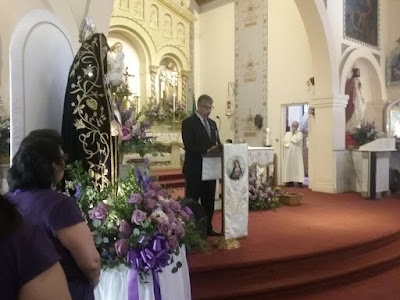The Feast of Maria Santissima Addolorata
The Feast of Maria Santissima Addolorata, or Our Lady of Sorrows, is a significant Catholic celebration that honors the Virgin Mary in her role as the sorrowful mother who endured great suffering and pain, particularly during the Passion of Christ. This feast is observed in various forms around the world, but it is especially prominent in Italy, where devotion to Our Lady of Sorrows is deeply rooted in cultural and religious practices.
Historical and Liturgical Context
Origins of the Feast:
- The devotion to Our Lady of Sorrows has its origins in the early Church, with roots in the biblical account of Mary’s suffering, particularly as prophesied by Simeon in Luke 2:34-35: “And Simeon blessed them and said to Mary his mother, ‘Behold, this child is appointed for the fall and rising of many in Israel, and for a sign that is opposed (and a sword will pierce through your own soul also), so that thoughts from many hearts may be revealed.’”
- The feast itself was formally instituted by Pope Pius VII in 1814 and later extended to the universal Church by Pope Pius X in 1913. It is celebrated on September 15th, the day after the Feast of the Exaltation of the Holy Cross, highlighting the close connection between Mary’s suffering and the suffering of Christ.
The Seven Sorrows of Mary:
- The feast focuses on the seven sorrows (or dolors) that Mary experienced in her life, which are:
- The prophecy of Simeon.
- The flight into Egypt.
- The loss of the Child Jesus in the temple.
- Mary meeting Jesus on the way to Calvary.
- The Crucifixion and death of Jesus.
- The body of Jesus being taken down from the Cross.
- The burial of Jesus.
- These sorrows are meditated upon during the feast, often through prayers like the Rosary of the Seven Sorrows.
- The feast focuses on the seven sorrows (or dolors) that Mary experienced in her life, which are:
Cultural Significance in Italy
Regional Celebrations:
- In Italy, the Feast of Maria SS Addolorata is marked by various regional celebrations, processions, and rituals. One of the most famous is in the town of Castelpetroso in Molise, where an apparition of the Virgin Mary as the Addolorata was reported in 1888. This event led to the construction of the Basilica of Our Lady of Sorrows, which is a major pilgrimage site. It is also celebrated in communities of Italian immigrants from that region in other parts of the World like the United States.
- The feast is often accompanied by processions where statues of the Addolorata, dressed in black and often with seven swords piercing her heart, are carried through the streets, symbolizing Mary’s deep sorrow.
Spiritual Importance:
- The feast is not only a day of mourning but also one of hope and solidarity with the suffering of Christ. It serves as a reminder of Mary’s role as a compassionate intercessor who understands human suffering and stands by the faithful in their trials.
Theological Significance
Catechism and Church Teaching:
- The Catholic Church teaches that Mary’s suffering, while unique, is a model of the Christian response to suffering. The Catechism of the Catholic Church (CCC 618) emphasizes that Christians are called to unite their sufferings with those of Christ, and Mary is the perfect example of this union.
Church Fathers:
- Early Church Fathers, such as St. Ambrose and St. Augustine, reflected on Mary’s sorrows as part of her unique participation in the redemptive work of Christ. This reflection laid the foundation for the later development of the Feast of Our Lady of Sorrows.
Conclusion
The Feast of Maria Santissima Addolorata is a profound expression of Marian devotion, focusing on Mary’s deep sorrow and suffering. It connects the faithful with the emotional and spiritual pain of the Virgin Mother, offering a way to meditate on the suffering of Christ and to find comfort in the intercession of Our Lady of Sorrows. The feast is rich in tradition, both liturgically and culturally, and continues to be a significant celebration within the Catholic Church, particularly in Italy and in the Italian diaspora.







No comments:
Post a Comment